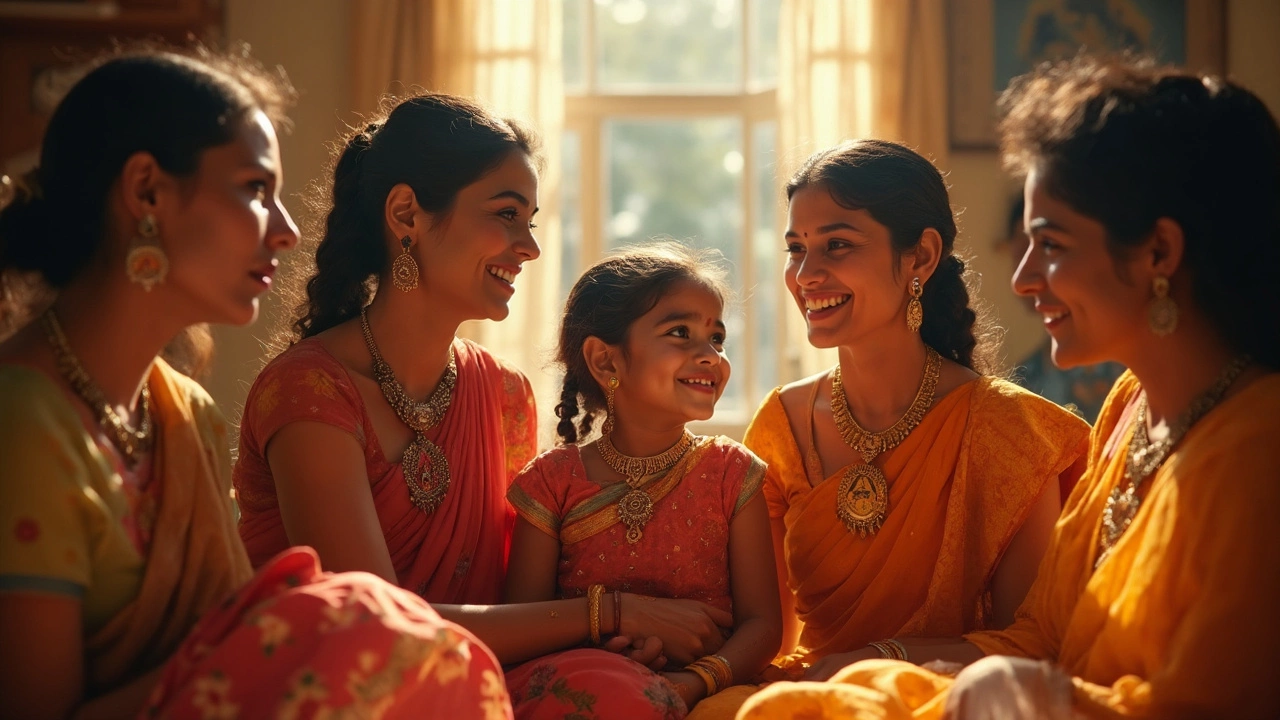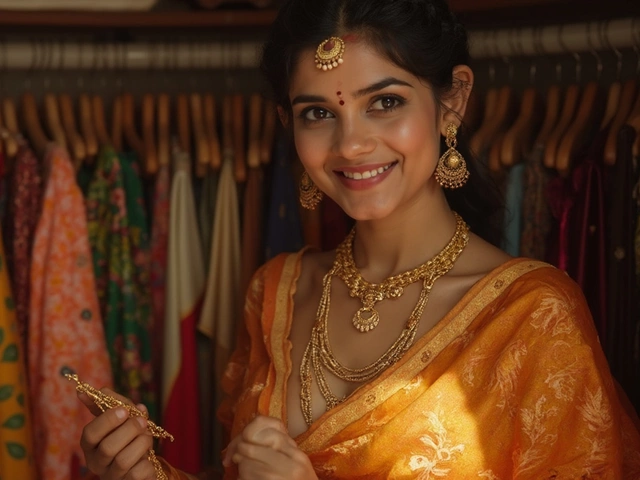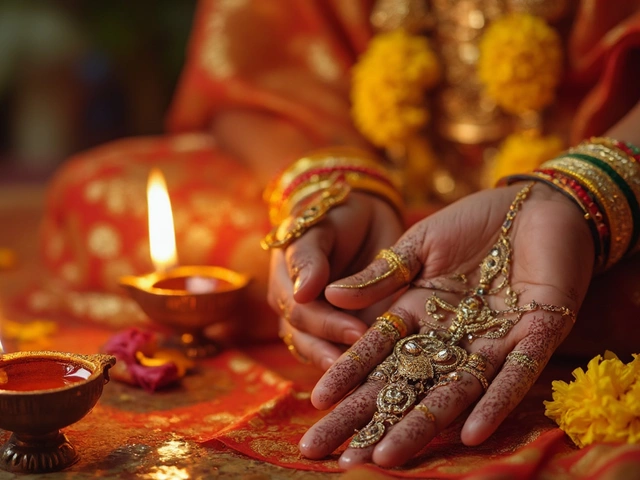If you walk into any big Indian gathering, whether it's a wedding, festival, or even a temple event, it's hard to miss the glitter. But it's not just about showing off—Indians wear jewelry for reasons that go way beyond the bling.
The connection starts early. Many Indian kids get their first gold chain or tiny anklets before they can even walk. Families hand down pieces that carry memories, a bit like passing the family WhatsApp group’s admin role—everyone wants it, and it means something. Some folks even believe that certain metals can keep you healthy or bring good luck. Sounds a bit superstitious? Maybe, but it shapes real choices every day.
- The Deep Roots of Indian Jewelry
- Temple Jewelry: More than Just Decoration
- Jewelry in Daily Life and Celebrations
- The Stories Behind Each Piece
- Tips to Wear and Care for Temple Jewelry
The Deep Roots of Indian Jewelry
Wearing jewelry in India goes way back—long before WhatsApp groups or Bollywood blockbusters. Archaeologists have found beads, nose rings, and bangles from the Indus Valley Civilization, which means people here have been into jewelry for at least 5,000 years. This isn’t just about status; the trend runs deep through religion, culture, and family life.
Each region in India has its own style. In the north, women love chunky gold necklaces and heavy earrings. Down south, you’ll spot longer chains and pieces inspired by temple sculptures. And it’s not just for women. Men wear gold rings, chains, and even earrings, especially during weddings and festivals.
Jewelry isn’t just an add-on for an outfit. In Hindu custom, gold is considered pure and is linked to wealth and well-being. During Akshaya Tritiya—a really popular day for buying gold—stores reportedly sell over 20 tons of gold across the country. Some families literally save for years just to buy a single gold ornament for a daughter’s wedding. Check out this data below to get a sense of how big jewelry really is here:
| Year | Gold Demand in India (Tons) | Major Jewelry Festivals |
|---|---|---|
| 2022 | 774 | Akshaya Tritiya, Diwali, Dhanteras |
| 2023 | 748 | Weddings, Durga Puja |
| 2024 | 790 | Pongal, Karva Chauth |
It’s not just about gold. Silver, diamonds, colored stones—Indians love mixing it up, depending on the occasion, budget, and tradition. Every piece can mean something: prosperity, protection, a family’s hopes, or even a religion’s blessing. All this sets the stage for the next level—special kinds of jewelry made just for temples and gods. That’s where temple jewellery really shines.
Temple Jewelry: More than Just Decoration
Temple jewelry isn’t just about adding sparkle to a traditional outfit—it’s loaded with deep meaning. Originally, this jewelry was made for deities in South Indian temples and not meant for regular folks. Skilled artisans, usually from Tamil Nadu and Kerala, would create these pieces in pure gold or silver, designed to decorate statues during big temple rituals. That’s why most of these items have shapes of gods, lotus flowers, bells, and peacocks.
These days, temple jewelry has moved out of temples and into homes. Dancers wear it in Bharatnatyam and Kuchipudi because it’s seen as pure and auspicious. Brides love it too, hoping to bring the blessings of the gods straight into their marriage.
If you’re wondering how to spot true temple jewelry, here are some clues:
- Usually heavy and solid—gold-plated or silver, not flimsy stuff.
- Major designs feature gods, goddesses, and temple motifs like bells and flowers.
- Handcrafted, often with tiny red and green stones (not flashy diamonds).
Even today, some families use the same temple jewelry for generations. The idea is: what protected the goddess can protect you. And if you check out a dance show or a festive South Indian wedding, you’ll notice how everyone’s talking about who wore which necklace or belt. It really becomes a whole conversation starter.
If you want solid proof of its popularity, look at exports. According to a 2023 report by the Gems & Jewellery Export Promotion Council, traditional Indian jewelry (with temple jewellery forming a major chunk) made up almost 34% of India's jewelry exports last year.
| Feature | Why it Matters |
|---|---|
| Heavy Gold/Gold-plated | Lasts for decades, fancied for weddings |
| Temple Motifs | Makes it easy to spot and gives spiritual meaning |
| Handcrafted | Every piece is unique |
| Red/Green Stones | Represents tradition and modesty vs. flashy stones |
So next time you see that chunky necklace on a dancer or a bride, remember, it’s not just plain jewellery—it’s tradition, art, and a little bit of spiritual protection, all rolled into one.
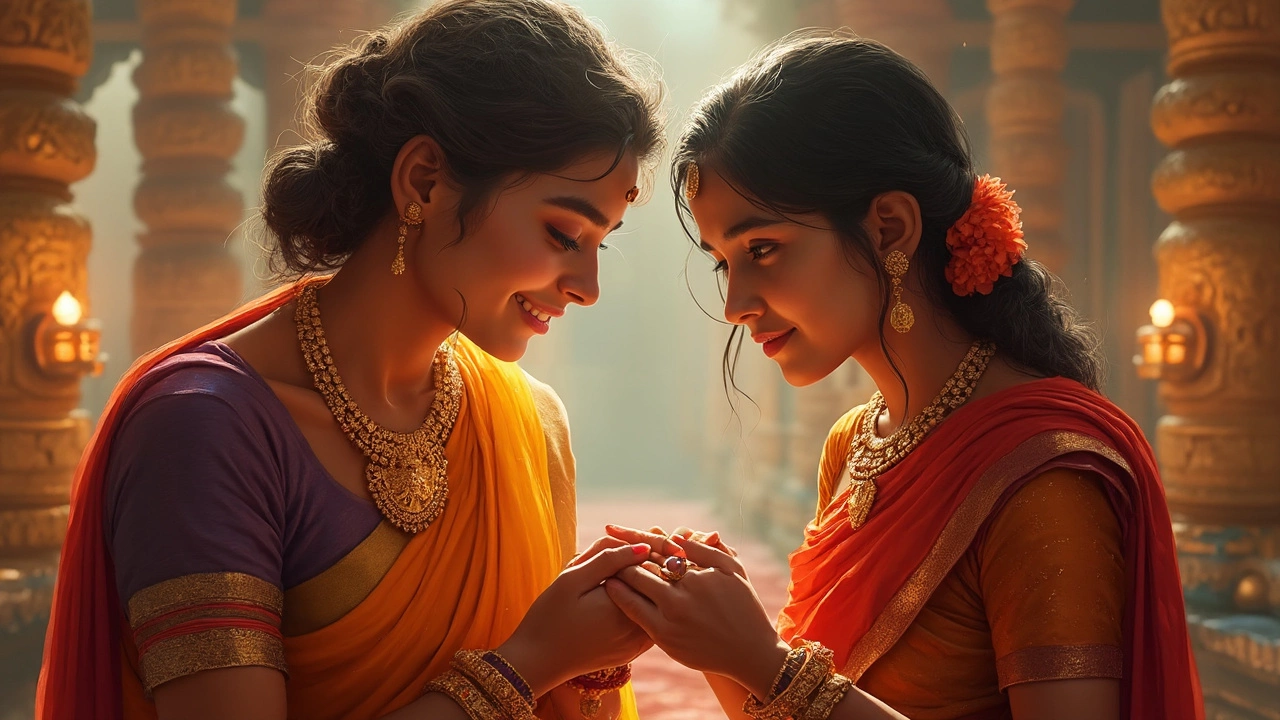
Jewelry in Daily Life and Celebrations
For Indians, jewelry is just part of the daily scene. It's not all tucked away and saved for weddings or big functions. Even on regular days, you'll spot people sporting a gold chain, simple studs, or plain bangles. It isn’t just about looking smart—these pieces often have deep roots in tradition and sometimes health beliefs. For example, older generations say wearing gold helps improve blood circulation. Silver anklets and toe rings are said to cool the body, especially in hot climates.
Now, step into the world of celebrations and the amount of jewelry instantly doubles—sometimes even more. During festivals like Diwali, Durga Puja, or Pongal, it’s common for everyone to deck up, with some families bringing out special sets saved just for these days. It’s also normal for people to buy new temple jewellery during festival sales or as a good-luck charm at Akshaya Tritiya, a day believed to bring wealth if you buy gold.
- Weddings: The average Indian bride might wear anywhere from 10 to 16 pieces of jewelry at once—necklaces, nose rings, armlets, toe rings, and more. More than half of rural women own gold jewelry, most of which is reserved for such occasions.
- Daily Life: Men and women often wear a chain with a religious pendant, sometimes hidden under their shirt but always there for luck or faith.
- Coming-of-Age Ceremonies: When a child gets their ears pierced, the first studs are a huge thing for the family. Same goes for baby showers, where gold or silver bracelets are standard gifts.
Check out this table for how jewelry fits into daily and special moments in India:
| Occasion | Type of Jewelry | Common Metal Used | Why It's Worn |
|---|---|---|---|
| Everyday | Chain, stud earrings, bangles | Gold, Silver | Tradition, health beliefs, protection |
| Weddings | Temple haram, vanki, nath, maang tikka | Gold | Cultural identity, family status, investment |
| Festivals | Temple sets, antique pieces | Gold, Silver, Gems | Spiritual, luck, celebration |
| Special Ceremonies | Anklets, toe rings, bracelets | Silver | Ritual, milestone protection |
There’s an actual practical side too. With gold prices shooting up—India alone bought nearly 800 metric tons in 2023, just behind China—jewelry acts as a fallback during money trouble. People pawn or sell their gold if needed, so it doubles up as a saving tool.
So whether it’s that thick gold chain your uncle wears every single day or the grand pieces everyone pulls out for weddings, jewelry keeps showing up everywhere, woven straight into regular routines and life’s big moments.
The Stories Behind Each Piece
Every bit of jewelry in India has a backstory. Ask someone about their earrings or that massive necklace, and you’ll likely learn it’s more than an impulse buy. Let’s talk specifics—some pieces are worn for faith, protection, or straight-up tradition.
Temple jewellery stands out. These chunky, gold pieces kicked off centuries ago for dancers and deities in South Indian temples. Even today, classical dancers like Bharatanatyam performers won’t hit the stage without them. It’s all about respect and style mashed together.
Take the ‘mangalsutra’—that black and gold beaded necklace married Hindu women wear. It signals marital status and is a symbol of strength. Anklets do their bit too. In some regions, mothers wrap newborns’ ankles in silver ‘payal’ to keep away bad vibes (and as a bonus, those tiny bells work better than any baby tracker app if you want to know where your toddler is on Diwali).
Nose rings aren’t just for looks. In North India, many brides wear them as part of wedding rituals, believed to make childbirth smoother according to old Ayurvedic ideas. Toe rings? Married women wear them, but some believe they help with menstrual health, thanks to gentle pressure points.
Check out some super-popular pieces and their meaning:
- Mangalsutra: Worn by married Hindu women.
- Temple necklace: Originally for temple dancers, now seen at big festivals and weddings.
- Nath (nose ring): Symbolizes marriage and, in some places, good health.
- Payal (anklets): Link to tradition, myth, and family memories.
- Jhumka (dangly earrings): Popular for both daily and festival wear—many believe they bring out inner joy.
Here’s a quick peek at a few pieces, their region, and when they’re usually worn:
| Jewelry | Popular Region | Typical Occasion |
|---|---|---|
| Temple Jewellery | South India | Dances, festivals |
| Mangalsutra | Maharashtra, North India | Daily, after marriage |
| Nath | Rajasthan, Punjab | Weddings |
| Payal | Gujarat, Bengal | Birth, weddings |
| Jhumka | All over India | Casual, festivals |
So next time you see someone wearing a ton of jewelry, remember—most pieces are packed with layers of meaning, history, and family stories. It’s far from just a fashion choice in India.
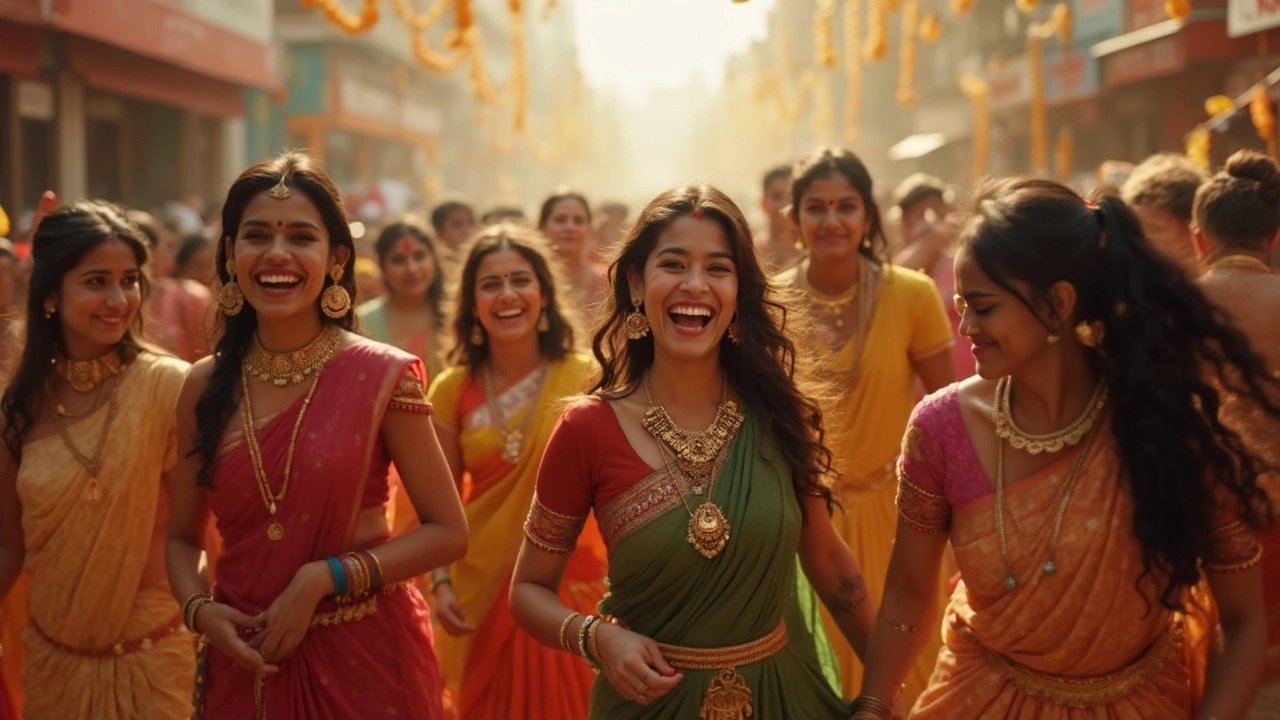
Tips to Wear and Care for Temple Jewelry
Temple jewelry stands out for its bold gold finish, chunky motifs, and religious symbols. Most people associate it with classical dancers or brides, but you don't have to wait for a big event to pull it out. Here’s how to really get the best out of your temple pieces.
- Mix and match smartly: These heavy ornaments pair best with sarees, lehengas, or traditional outfits. But you can also wear a single statement piece—like a chunky pendant or big jhumka earrings—with a plain kurta or a shirt. No need to overload every time.
- Layering tip: Don’t mix too many metals or styles together. If you’re wearing a temple necklace, let that take the spotlight. Skip extra-long earrings or heavy bangles with an elaborate neckpiece.
- Pick the right time: Most temple jewellery is gold-plated brass or silver, so it’s not for gym or pool use. Humidity and sweat can make the plating fade faster. Save it for indoor events or mild weather.
Taking care of these pieces isn’t rocket science, but a few easy habits can make them last for years:
- Keep it dry: After wearing, wipe pieces with a soft cotton cloth before putting them away. Moisture causes tarnish and dullness.
- Store smart: Always keep your temple jewellery in a fabric-lined box or pouches. Separating pieces prevents scratches and broken stones.
- Avoid chemicals: Perfume, deodorant, or even regular hand lotion can ruin the finish. Put the jewelry on last, after all body products.
- Gentle cleaning: Once a month, use a mild soap solution and a soft toothbrush to clean. Skip harsh cleaners or fancy polish; those often do more harm than good.
Curious about durability and common issues? Here’s a quick comparison table for popular temple jewelry metals:
| Metal | Commonly Used For | Durability | Things to Watch |
|---|---|---|---|
| Gold-plated Brass | Pendants, earrings | Medium (3-5 years with care) | Plating can wear off, avoid water |
| Silver | Heavy necklaces, anklets | High (can last decades) | Tarnishes with air, needs polishing |
| Pure Gold | Premium sets, heirlooms | Very high | Expensive, softer so avoid knocks |
If your jewelry breaks or loses shine, don’t freak out. Small shops and goldsmiths in Indian cities specialize in repairs and replating for surprisingly low prices. Taking time for regular checks can keep your favorite pieces looking sharp, whether you wear them for a wedding or just to spice up a simple outfit.
